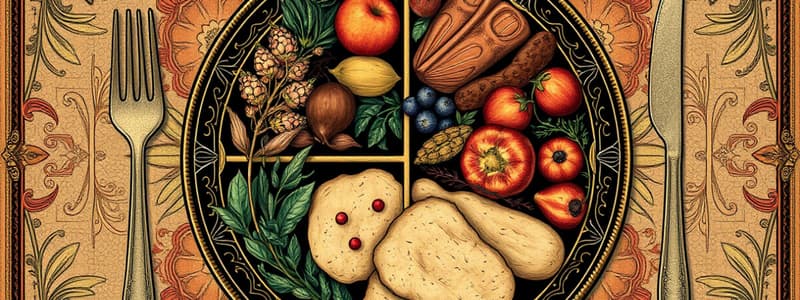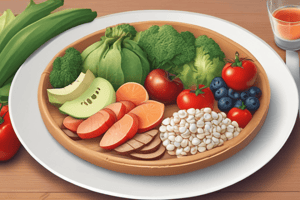Podcast
Questions and Answers
What is the recommended daily intake of vegetables for a 12-year-old male?
What is the recommended daily intake of vegetables for a 12-year-old male?
- 3 cups (correct)
- 4 cups
- 2½ cups
- 2 cups
How many ounces of protein should a 12-year-old female consume each day?
How many ounces of protein should a 12-year-old female consume each day?
- 6 ounces
- 5½ ounces (correct)
- 5 ounces
- 4 ounces
Which of the following is an appropriate serving size of grains for a 12-year-old male?
Which of the following is an appropriate serving size of grains for a 12-year-old male?
- 6 ounces
- 7 ounces (correct)
- 8 ounces
- 5 ounces
What food group is not included in MyPlate due to its recommended limited intake?
What food group is not included in MyPlate due to its recommended limited intake?
What is one of the three key concepts to remember when combining food groups for healthful meals?
What is one of the three key concepts to remember when combining food groups for healthful meals?
What is the primary purpose of MyPlate?
What is the primary purpose of MyPlate?
Which of the following statements accurately describes the dairy group?
Which of the following statements accurately describes the dairy group?
What is the daily recommended amount of fruit for both 12-year-old females and males?
What is the daily recommended amount of fruit for both 12-year-old females and males?
How many food groups does MyPlate include?
How many food groups does MyPlate include?
Which vegetable type is included in the dietary recommendations?
Which vegetable type is included in the dietary recommendations?
Why is it important to include flexibility in meal planning according to MyPlate guidelines?
Why is it important to include flexibility in meal planning according to MyPlate guidelines?
What is the significance of choosing a variety of foods from different food groups?
What is the significance of choosing a variety of foods from different food groups?
What proportion of grains in your diet should ideally be whole grains?
What proportion of grains in your diet should ideally be whole grains?
In a balanced meal, what role does the vegetable group play according to MyPlate recommendations?
In a balanced meal, what role does the vegetable group play according to MyPlate recommendations?
What is one common misconception about fats in a healthful diet?
What is one common misconception about fats in a healthful diet?
When planning meals, what should be taken into consideration regarding caloric intake and physical activity?
When planning meals, what should be taken into consideration regarding caloric intake and physical activity?
What would be an ideal food combination for a meal according to MyPlate guidelines?
What would be an ideal food combination for a meal according to MyPlate guidelines?
Which of the following foods is classified as a whole grain?
Which of the following foods is classified as a whole grain?
What does moderation in eating emphasize?
What does moderation in eating emphasize?
What is a recommended daily caloric intake for a moderately active teen?
What is a recommended daily caloric intake for a moderately active teen?
If a teen consumes more calories than they burn, what is the expected outcome?
If a teen consumes more calories than they burn, what is the expected outcome?
When selecting food for lunch at school, what should students consider?
When selecting food for lunch at school, what should students consider?
Why might teens in sports or dance teams require more calories?
Why might teens in sports or dance teams require more calories?
What should be included to make a healthful breakfast?
What should be included to make a healthful breakfast?
To adhere to the MyPlate guidelines, what proportion of your plate should consist of vegetables and fruits at lunch and dinner?
To adhere to the MyPlate guidelines, what proportion of your plate should consist of vegetables and fruits at lunch and dinner?
What is a more healthful alternative to traditional snack foods like potato chips?
What is a more healthful alternative to traditional snack foods like potato chips?
Which of the following is considered a nutrient-dense snack?
Which of the following is considered a nutrient-dense snack?
Why is breakfast considered an important meal of the day?
Why is breakfast considered an important meal of the day?
When looking at a Nutrition Facts label, what should you keep in mind regarding servings?
When looking at a Nutrition Facts label, what should you keep in mind regarding servings?
What is a healthful dessert option mentioned in the content?
What is a healthful dessert option mentioned in the content?
Which type of bread is recommended for sandwiches to enhance whole grain intake?
Which type of bread is recommended for sandwiches to enhance whole grain intake?
Which of the following is NOT considered a quick healthful breakfast option?
Which of the following is NOT considered a quick healthful breakfast option?
What role do snacks play in the meal plans of growing teens?
What role do snacks play in the meal plans of growing teens?
Study Notes
Understanding MyPlate
- MyPlate serves as a visual guide designed to promote healthier food choices and ensure balanced nutrient intake.
- Developed by the USDA in collaboration with nutrition experts, MyPlate categorizes foods into five distinct groups.
- Each food group is essential for overall health, providing different necessary nutrients.
- A balanced meal should comprise foods from all five groups, contributing to comprehensive nutrient intake.
The Five Food Groups
-
Grains: Includes grains like rice, corn, wheat, oats, and barley. About half should be whole grains (e.g., whole-wheat bread, brown rice).
- Daily recommendations: 6 ounces for females and 7 ounces for males aged 12.
-
Vegetables: Offers a wide variety, including fresh, frozen, or canned. Leafy greens and starchy vegetables are key components.
- Daily recommendations: 2½ cups for females and 3 cups for males aged 12.
-
Fruits: Can be fresh, frozen, or canned and must be included daily.
- Daily recommendations: 2 cups for both females and males aged 12.
-
Dairy: Comprises milk, cheese, and yogurt. Opt for low-fat or fat-free options.
- Daily recommendations: 3 cups for both females and males aged 12.
-
Protein: Includes meat, fish, beans, peas, eggs, and nuts.
- Daily recommendations: 5½ ounces for females and 6 ounces for males aged 12.
-
Fats: Not explicitly shown on MyPlate; should be consumed in moderation. Common sources include butter, oils, and fatty meats.
Meal Planning and Flexibility
- Focus on three key principles for healthy meals: variety, moderation, and balance.
- Breakfast is crucial after long hours of sleep; options high in complex carbohydrates and protein (e.g., oatmeal, eggs) are beneficial.
- For quick breakfasts, consider fruits, whole-grain bread, or cheese.
- At lunch and dinner, aim to fill half your plate with vegetables and fruits.
- Snacks for teens should be nutrient-dense (e.g., fruits, popcorn, whole-grain crackers) rather than high in fats and sugars.
Nutrition Facts and Moderation
- Nutrition Facts labels help assess the healthfulness of packaged foods, comparing calorie and nutrient content.
- Moderation entails keeping portion sizes reasonable and limiting empty-calorie foods like sweets and soda.
- Balance calorie intake with physical activity to maintain healthy weight; monitor caloric consumption relative to daily burn.
Physical Activity Recommendations
- Moderately active teens typically burn around 2,000 calories daily.
- Weight management can be achieved by consuming fewer than 2,000 calories or increasing physical activity.
- Health professionals suggest 60 minutes of physical activity per day, especially for teens in sports, who may have higher caloric needs while still prioritizing nutrient-rich foods.
Studying That Suits You
Use AI to generate personalized quizzes and flashcards to suit your learning preferences.
Related Documents
Description
This quiz explores MyPlate, a visual guide created to help individuals make informed food choices for a balanced diet. It covers the five food groups and their daily recommendations to ensure adequate nutrient intake. Test your knowledge on how each group contributes to overall health.




